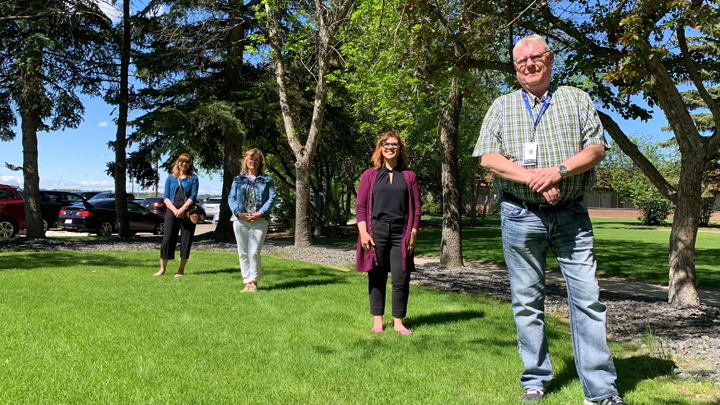
July 9, 2020

Maintaining physical distance from each other as they keep their clients connected to care are members of the Lethbridge Addiction and Mental Health Outreach Team, from right: Jim McCran, Tammie Efraimson-Hiraga, Brandy Tonin and Janet Innes.
Story & photo by Sherri Gallant
When the situation calls for people to stay apart from one another, providing group therapy becomes a challenge. During the COVID-19 pandemic, mental health and recreation therapists in the South Zone of Alberta Health Services (AHS), along with other regions of the province, have had to get creative.
By using technology such as Zoom and Skype, the Addiction and Mental Health Outreach Team in Lethbridge has kept therapy groups running, almost without missing a beat. They’ve been able to glean advice from colleagues in Medicine Hat — who’ve already started some virtual groups — and also receive invaluable support from the AHS Virtual Health Team, says Paul Weiss, Outreach Team manager.
The team also draws from their own experience in virtually connecting psychiatrists with their clients who have Community Treatment Orders (CTO).
“We’re working with about 100 CTO clients,” says Weiss, “Those treatment orders are reviewed periodically, and now the review panels are also meeting via Zoom. No one has to travel to attend a meeting. It’s so much better.”
Group therapy and relaxation groups have moved online. Three months into the process, some clients are discovering the new process actually works better for them.
“We’re continually adapting to use the things that have worked,” says Weiss, “and while virtual is not the best format for everything, we know now that after COVID is over, some virtual meetings will keep going where we’ve learned they work well.”
“It evolved very quickly,” adds Brandy Tonin, Recreation Therapist. “We recognized that clients who benefit from coming to group need that to continue. We asked ourselves how we could retain a semblance of the group dynamic to meet the need people have for connection. It’s not perfect, but it does provide that connection to a certain extent because even hearing the voices of others in the group, being able to see my face and others’ faces, is what participants need.”
Janet Innes, a Mental Health Therapist, says the team has been further challenged with finding how to meet the needs of clients who have no access to Wi-Fi or the Internet.
“We created a relaxation group they can connect to with Skype using just a landline or a cell phone,” Innes says. “We’ve had really good attendance with that. They’ve all been coming.
“Many clients who were coming in person benefit greatly because it’s a connection they wouldn’t otherwise have. If they’re connecting by phone, they can still say good morning to each other; they just can’t see each other. For clients who have a lot of anxiety, or transportation issues, and for those who had to drive in from other communities, this has been a success.”
Innes adds that one woman had just begun to attend groups before COVID-19 and expressed worry that they wouldn’t continue.
“She’s really thankful, because she can do the practice in her own home now. For her, there’s less anxiety attending relaxation group because she can shut her video off and doesn’t have to talk. Another man from the Crowsnest Pass had been driving in to Lethbridge once a week to attend, and now that he doesn’t have to make that drive, he attends more often.”
Weiss says on average about 100 individuals attend half a dozen different groups virtually – about the same number who attended prior to COVID-19. Recreation groups have expanded to include Crowsnest Pass and Fort Macleod. Plans are also in the works to create an overall South Zone group — something that can only occur virtually — and that Weiss says wouldn’t have been thought of were it not for the recent changes brought on by the pandemic.
Virtual meetings aren’t ideal for everything, however. Innes explains that when clients are processing complex emotions in group therapy, they require the safety of the therapist and the group being present.
Tammie Efraimson-Hiraga, a Mental Health Therapist, has relied upon phone check-ins with clients for a long time — and that continues.
“About two thirds of my client time is spent on the telephone calling and texting — and a third of my clients I still see face-to-face, with physical distancing in place,” she says. “Phone check-ins work fine for those who aren’t food-insecure, have enough income and are housed. Those we see in person have fewer natural supports and often face financial and housing problems.”
Efraimson-Hiraga and her colleague Jim McCran use virtual technology to link homeless and CTO clients with other resources.
“It’s something we do to ensure our clients are able to stay connected with their psychiatrists,” she says. “Jim uses Zoom or Skype and I have done calls on my cell phone from the client’s home to the psychiatrist, and with three-way calling when an interpreter is required. It’s been so important for the consults with the psychiatrists to continue.
“The technology is not something our most vulnerable clients are able to access, so those face-to-face meetings are an important aspect of care.”
Weiss says some symptomatic homeless people were temporarily housed at a local motel until their COVID test results were known. “The doctors can’t go see them there and the clients aren’t supposed to leave during their quarantine, so a virtual connection works well.”
The outreach team tends to see the really vulnerable, at-risk population, Weiss says.
“They don’t often have the means to connect. The added challenge is that we typically rely pretty heavily on other resources and some of their doors have closed — so to advocate for our clients’ needs we’ve really had to go through some different steps.”